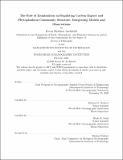| dc.contributor.advisor | Michael G. Neubert and Heidi M. Sosik. | en_US |
| dc.contributor.author | Archibald, Kevin Matthew. | en_US |
| dc.contributor.other | Joint Program in Oceanography/Applied Ocean Science and Engineering. | en_US |
| dc.contributor.other | Massachusetts Institute of Technology. Department of Earth, Atmospheric, and Planetary Sciences. | en_US |
| dc.contributor.other | Woods Hole Oceanographic Institution. | en_US |
| dc.date.accessioned | 2021-05-24T20:22:49Z | |
| dc.date.available | 2021-05-24T20:22:49Z | |
| dc.date.copyright | 2021 | en_US |
| dc.date.issued | 2021 | en_US |
| dc.identifier.uri | https://hdl.handle.net/1721.1/130751 | |
| dc.description | Thesis: Ph. D., Joint Program in Oceanography/Applied Ocean Science and Engineering (Massachusetts Institute of Technology, Department of Earth, Atmospheric, and Planetary Sciences; and the Woods Hole Oceanographic Institution), February, 2021 | en_US |
| dc.description | Cataloged from the official PDF of thesis. | en_US |
| dc.description | Includes bibliographical references (pages 127-135). | en_US |
| dc.description.abstract | In this thesis, I explore two topics in plankton ecology with a combination of models and observations. First, I investigate the contribution of zooplankton diel vertical migration (DVM) to the vertical flux of carbon as part of the biological pump. I do this by constructing and analyzing a global model that includes DVM and is driven by satellite-based estimates of primary productivity. There has long been speculation about the significance of DVM to the biological pump, but quantitative estimates of its impact are rare. I estimate that DVM constitutes approximately 16% of the global carbon export flux associated with the biological pump and that the relative contribution of DVM is higher in subtropical latitudes. In later chapters, I build two nutrient-phytoplankton-zooplankton (NPZ) models with different levels of complexity to evaluate the role of nutrient supply and grazing in promoting phytoplankton diversity. | en_US |
| dc.description.abstract | Zooplankton switching plays a significant role in promoting diversity because it allows competing phytoplankton types to coexist in situations that would otherwise lead to competitive exclusion. When implemented in a size-structured NPZ model, stronger switching increases the evenness of the distribution of biomass between coexisting size classes, which is used as a proxy for taxonomic diversity. I also describe a particular characteristic of the Kill-the-Winner functional response (used in the NPZ models), which I have termed synergistic grazing. Synergistic grazing occurs when the grazing rate on one phytoplankton type increases as the biomass of an alternative phytoplankton type increases. This characteristic can result in unintuitive model dynamics. Finally, I describe patterns in phytoplankton community size structure in the shelfbreak region of the Northeast U.S. Shelf using high-resolution flow-cytometry measurements. | en_US |
| dc.description.abstract | I find that enhancement of phytoplankton biovolume at the shelfbreak front is common during the springtime, but these enhancement events are not associated with consistent changes in community size structure. I evaluate these results in the context of hypotheses generated based on my analysis of the NPZ models. | en_US |
| dc.description.statementofresponsibility | by Kevin Matthew Archibald. | en_US |
| dc.format.extent | 135 pages | en_US |
| dc.language.iso | eng | en_US |
| dc.publisher | Massachusetts Institute of Technology | en_US |
| dc.rights | MIT theses may be protected by copyright. Please reuse MIT thesis content according to the MIT Libraries Permissions Policy, which is available through the URL provided. | en_US |
| dc.rights.uri | http://dspace.mit.edu/handle/1721.1/7582 | en_US |
| dc.subject | Joint Program in Oceanography/Applied Ocean Science and Engineering. | en_US |
| dc.subject | Earth, Atmospheric, and Planetary Sciences. | en_US |
| dc.subject | Woods Hole Oceanographic Institution. | en_US |
| dc.title | The role of zooplankton in regulating carbon export and phytoplankton community structure : integrating models and observations | en_US |
| dc.type | Thesis | en_US |
| dc.description.degree | Ph. D. | en_US |
| dc.contributor.department | Joint Program in Oceanography/Applied Ocean Science and Engineering | en_US |
| dc.contributor.department | Massachusetts Institute of Technology. Department of Earth, Atmospheric, and Planetary Sciences | en_US |
| dc.contributor.department | Woods Hole Oceanographic Institution | en_US |
| dc.identifier.oclc | 1251897024 | en_US |
| dc.description.collection | Ph.D. Joint Program in Oceanography/Applied Ocean Science and Engineering (Massachusetts Institute of Technology, Department of Earth, Atmospheric, and Planetary Sciences; and the Woods Hole Oceanographic Institution) | en_US |
| dspace.imported | 2021-05-24T20:22:49Z | en_US |
| mit.thesis.degree | Doctoral | en_US |
| mit.thesis.department | EAPS | en_US |
